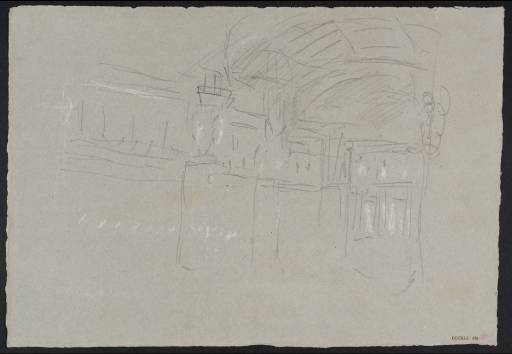Joseph Mallord William Turner The Interior of the Walhalla, at Donaustauf near Regensburg 1840
Joseph Mallord William Turner,
The Interior of the Walhalla, at Donaustauf near Regensburg
1840
Joseph Mallord William Turner 1775–1851
The Interior of the Walhalla, at Donaustauf near Regensburg 1840
D34084
Turner Bequest CCCXLI 363
Turner Bequest CCCXLI 363
Chalk and pencil on grey wove paper, 192 x 278 mm
Blind-stamped with Turner Bequest monogram towards bottom right
Inscribed in red ink ‘363’ bottom right (now faint)
Stamped in black ‘CCCXLI – 363’ bottom right
Blind-stamped with Turner Bequest monogram towards bottom right
Inscribed in red ink ‘363’ bottom right (now faint)
Stamped in black ‘CCCXLI – 363’ bottom right
Accepted by the nation as part of the Turner Bequest 1856
Exhibition history
1999
Turner’s Later Papers: A Study of the Manufacture, Selection and Use of his Drawing Papers 1820–1851, Tate Gallery, London, March–June 1999 (59, as part of ‘Reassembled sheet made up of seven different works with views of Regensburg and the Walhalla’, 1840, reproduced in colour).
References
1830
A.J. Finberg, A Complete Inventory of the Drawings of the Turner Bequest, London 1909, vol.II, p.1087, CCCXLI 363, as ‘Interior of a building’, c.1830–41.
1995
Cecilia Powell, Turner in Germany, exhibition catalogue, Tate Gallery, London 1995, pp.70, 82 note 53, 168 under nos.96 and 97, 180 under no.109, fig.54, as ‘The interior of the Walhalla’, 1840.
1999
Peter Bower, Turner’s Later Papers: A Study of the Manufacture, Selection and Use of his Drawing Papers 1820–1851, exhibition catalogue, Tate Gallery, London 1999, reproduced in colour p.69, pp.105, 107 no.59, as part of ‘Reassembled sheet made up of seven different works with views of Regensburg and the Walhalla’, 1840.
2001
Cecilia Powell, ‘Walhalla’ in Evelyn Joll, Martin Butlin and Luke Herrmann eds., The Oxford Companion to J.M.W. Turner, Oxford 2001, p.370.
Turner visited Donaustauf, on the north bank of the River Danube about five miles east of Regensburg in southern Germany, to see the Greek temple-style Walhalla monument, then nearing completion ahead of its opening in 1842. He made numerous pencil drawings in the vicinity in the contemporary Venice, Passau to Würzburg book; see under Tate D31341 (Turner Bequest CCCX 33a) for further details. Cecilia Powell identified the present work as ‘a quick sketch of its unfinished interior’.1
King Ludwig I of Bavaria (ruled 1825–1848) had been planning a Hall of Fame to commemorate prominent Germans since the events of the Napoleonic War had stirred feelings of Romantic nationalism. Marble busts of royal, military, scientific, literary and artistic figures had already been in preparation for many years when building commenced in 1830, and by the time of Turner’s visit the building was nearing completion ahead of its opening in October 1842. Additions are still made from time to time.2
The elaborately decorated but essentially barn-like interior is notionally divided into thirds by the projecting supports with paired polychromatic caryatid figures below the main roof trusses, with the busts arrayed within the wide alcoves. Looking from near the south entrance, Turner articulates the west side of the hall, with the columned recess at the far end on the right, with a few deft pencil strokes, with the busts (or perhaps just their individual corbelled plinths at this stage) picked out in white against the bare mid-tone of the paper which fortuitously stands for the grey marble walls. Contemporary engravings show a simple coffered pitched ceiling with three large skylights,3 as seen today, but Turner seems to have improvised a shallow barrel vault, perhaps either through haste or poor light. He also managed to make a slight sketch of part of the interior and a rough but serviceable ground plan inside the covers of the Venice, Passau to Würzburg book (Tate D41400–D41401).
As discussed in the technical notes below, the present study is one of seven of Regensburg and the Walhalla (see also Tate D32185, D34081, D34085, D34093, D36150, D36153; Turner Bequest CCCXVII 6, CCCXLI 360, 364, 371, CCCLXIV 293, 296) which were initially eighths of a single sheet; D36151 (CCCLXIV 294) is a related view on similar paper. Of these, D34085 and D34093 show the Walhalla in its landscape setting. See also a loose watercolour study on conventional white paper (Tate D36174; Turner Bequest CCCLXIV 316).
Technical notes:
Among many such works on the blue or grey papers customarily used by Turner, this is one of seven originally from a single piece (subsequently scattered through Finberg’s 1909 Inventory, as listed above) to be identified by Cecilia Powell as showing subjects in and around Regensburg.1 They are from an 1829 sheet of the grey Bally, Ellen and Steart paper often used in 1840 (see the Introduction to the overall tour), and were temporarily reassembled for paper conservator Peter Bower’s 1999 Turner’s Later Papers exhibition, showing that their slightly irregular edges match exactly.2
Four subjects were drawn on one side, and three on the other, only one face of each eighth being used, with a last section unaccounted for. Bower has noted Turner’s habit of tearing such sheets, sometimes in advance or sometimes after making a sequence of sketches, unfolding and refolding the intact sheet as necessary.3 The delicate white chalk highlights on several, and the lively gouache and watercolour on three (noted in individual entries), was likely added once the sheets were separated, as suggested particularly by the colour having been freely worked up to the torn edges, with no sign of overlapping brushwork or adventitious splashes across originally neighbouring areas.
Verso:
Blank; inscribed in pencil ‘363’ below right of centre.
Matthew Imms
September 2018
How to cite
Matthew Imms, ‘The Interior of the Walhalla, at Donaustauf near Regensburg 1840 by Joseph Mallord William Turner’, catalogue entry, September 2018, in David Blayney Brown (ed.), J.M.W. Turner: Sketchbooks, Drawings and Watercolours, Tate Research Publication, December 2019, https://www

